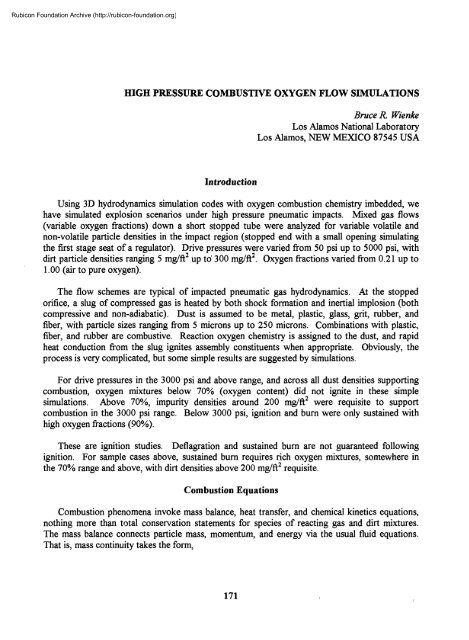Nitrox workshop dings - Divers Alert Network
Nitrox workshop dings - Divers Alert Network
Nitrox workshop dings - Divers Alert Network
Create successful ePaper yourself
Turn your PDF publications into a flip-book with our unique Google optimized e-Paper software.
Rubicon Foundation Archive (http://rubicon-foundation.org)HIGH PRESSURE COMBUSTTVE OXYGEN FLOW SIMULATIONSBruce R. WienkeLos Alamos National LaboratoryLos Alamos, NEW MEXICO 87545 USAIntroductionUsing 3D hydrodynamics simulation codes with oxygen combustion chemistry imbedded, wehave simulated explosion scenarios under high pressure pneumatic impacts. Mixed gas flows(variable oxygen fractions) down a short stopped tube were analyzed for variable volatile andnon-volatile particle densities in the impact region (stopped end with a small opening simulatingthe first stage seat of a regulator). Drive pressures were varied from 50 psi up to 5000 psi, withdirt particle densities ranging 5 mg/ft 2 up to 300 mg/ft 2 . Oxygen fractions varied from 0.21 up to1.00 (air to pure oxygen).The flow schemes are typical of impacted pneumatic gas hydrodynamics. At the stoppedorifice, a slug of compressed gas is heated by both shock formation and inertial implosion (bothcompressive and non-adiabatic). Dust is assumed to be metal, plastic, glass, grit, rubber, andfiber, with particle sizes ranging from 5 microns up to 250 microns. Combinations with plastic,fiber, and rubber are combustive. Reaction oxygen chemistry is assigned to the dust, and rapidheat conduction from the slug ignites assembly constituents when appropriate. Obviously, theprocess is very complicated, but some simple results are suggested by simulations.For drive pressures in the 3000 psi and above range, and across all dust densities supportingcombustion, oxygen mixtures below 70% (oxygen content) did not ignite in these simplesimulations. Above 70%, impurity densities around 200 mg/ft 2 were requisite to supportcombustion in the 3000 psi range. Below 3000 psi, ignition and burn were only sustained withhigh oxygen fractions (90%).These are ignition studies. Deflagration and sustained burn are not guaranteed followingignition. For sample cases above, sustained burn requires rich oxygen mixtures, somewhere inthe 70% range and above, with dirt densities above 200 mg/ft 2 requisite.Combustion EquationsCombustion phenomena invoke mass balance, heat transfer, and chemical kinetics equations,nothing more than total conservation statements for species of reacting gas and dirt mixtures.The mass balance connects particle mass, momentum, and energy via the usual fluid equations.That is, mass continuity takes the form,171
















